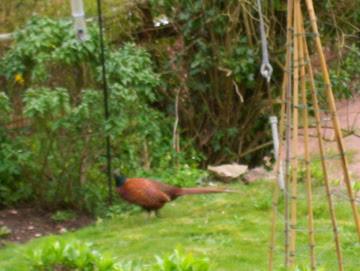
Raspberry PreservesIn answer to Gillybean’s comment :
Bread and Jam have been staples in our house for years. For many reasons, partly because we are addicted to sweet things ( as most people) and because it is such a simple snack. I have been making jams from our fruit harvest for years because I like rows and rows of it in my larder ( as any sugar addict will know, you like it to be available!) but also because it makes nice presents to give to others when I visit. Our favourites are raspberry, strawberry, blackberry and apple ,and plum ( of all sorts).. I did make marmelade last year but I usually make it for the older people in our village who no longer make it and have grown up with toast and marmelade.
The 3 rules to making jam are that you need a sugar concentration of 60 to 65%, a pectin content of 0.5 to 1 % and a PH of 2.8 to 3.4 ( acid).
That is the scientific rule. Jam is a good way of preserving fruit and although messy at times, quite fun to do too.
In addition you need jars and a preserving pan.
Jam is made up usually of about 65% sugar. There are sugar free spreads available on the market and fruitspreads which are not jam, but in order to make jam with other ingredients, such as honey.....? What would be the answer.
It is possible to make jam with less sugar but it requires more pectin. Much of that is commercial and chemical.
I tried to make some raspberry jam with less sugar, as pectin is high in raspberries but it was a bit tart! If you cut down on too much sugar, then you risk using not enough to preserve the fruit and could end up with a scientific mould experiment in the cupboard.
Honey can be used to replace sugar. Light, mild flavoured honey would be the best kind to use as the flavour is not likely to compete with the flavours of the fruit. In recipes without added pectin, honey can replace 50% of the sugar. When pectin is added, 2 cups of honey can replace 2 cups of sugar in most recipes; 3/4 to 1 cup sugar can be replaced by honey in recipes with a smaller yield, up to 6 half pints.
Ball Blue Book of preserving
In the USA pectin is available freely and my sister in law in Canada has been known to send me some for Christmas as a gift. Last year I tried
Pomona Universal Pectin which is a natural pectin extracted from lemons. The jam is of course less sugary ( which did not appeal to the boys as yet) but I believe it is the only way currently to achieve a reduced sugar jam using pectin, honey, and you could also experiment with artificial sweeteners if you so wish.
My reason for reducing sugar and using honey is that honey, locally obtained, is a sweet product that as yet is untouched by chemicals ( apart from what the bees get as a byproduct). In addition to honey, the bees would pollinate the fruit trees and flowers and we would gain all around. ( That would be the principle behind it for me anyhow).
When the boys are older it certainly will bee ( ha) something that I will look into. We have a small copse area that could house some hives. To do that though I would have to overcome my squeamishness about bees and their stings and calm down an awful lot more into a relaxed lifestyle. Honey and beeswax have for centuries contributed to health and beauty products people made at home. Imported sugar was easier to obtain but it leaves a legacy of addiction which I have talked about previously and it travels many food miles to get to us.
I am working on producing a larder that has sufficient quantities of food in storage for 1 year for my family and the suggested amounts of preserves are as follows:
The family preparedness book by
James Talmage Stevens suggests that an adult’s annual consumption in your larder of sugary goods should look something like this :
70 llbs of honey ( stores indefinitely)
10 lbs of sugar ( white, brown, maple)
Honey is sweeter than sugar and also has more calories per spoon than sugar.
Fruit and vegetables are preserved using canning and dehydration mainly.
Jam stores for 12 months. I have a rotation and bearing in mind that tastes change and fashions change, make far too much for the needs of my family. Outlets could be gifts, farmers markets or alternatively, making jam for others or reducing the amounts you make.
One of the gift baskets I make for Christmas is a Cream Tea basket which has the recipe and ingredients of scones, 2 pots of jam, a small table cloth and 2 napkins in a small basket. Sufficient for summer days, in the garden, at the beach or out on a picnic for 2.
The rule is, jam tomorrow and jam yesterday - but never jam today.
Lewis Carroll
 The sallow tree in our garden has a buzzing sound surrounding it. This is a native tree of the British Isles and the first one to provide pollen and food for the bees and insects. It is quite a fantastic experience to see bees and other insects humming around. To us it means that spring really cannot be far away although the cold nights and frosts could tell us otherwise.
The sallow tree in our garden has a buzzing sound surrounding it. This is a native tree of the British Isles and the first one to provide pollen and food for the bees and insects. It is quite a fantastic experience to see bees and other insects humming around. To us it means that spring really cannot be far away although the cold nights and frosts could tell us otherwise. This is the first earlies planted at the end of February, they will provide us with potatoes at the end of April, May time. Just need to water them regularly, hoe and keep the chickens off.....
This is the first earlies planted at the end of February, they will provide us with potatoes at the end of April, May time. Just need to water them regularly, hoe and keep the chickens off..... Even when the weather is dull, the broad bean plants provide some colour in the poly tunnel. We are not great fans of broad beans but they add nitrogen to the soil and I like them stir fried with bacon, feta cheese, small tomatoes on a bed of rocket. That's something to look forward to in a few months.
Even when the weather is dull, the broad bean plants provide some colour in the poly tunnel. We are not great fans of broad beans but they add nitrogen to the soil and I like them stir fried with bacon, feta cheese, small tomatoes on a bed of rocket. That's something to look forward to in a few months.


















